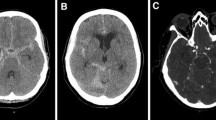Abstract
Background
The present study examined the computed tomography (CT) findings after surgery and overnight drainage for chronic subdural hematoma (CSDH) to clear the significance of inner superficial subarachnoid CSF space and outer subdural hematoma cavity between the brain surface and the inner skull.
Methods
A total of 73 sides in 60 patients were evaluated. Head CT was performed on the day after surgery and overnight drainage (1st CT), within 3 weeks of surgery (2nd CT), and more than 3 weeks after surgery (3rd CT). Subdural and subarachnoid spaces were identified to focus on density of fluid, shape of air collection, and location of silicone drainage tube, etc. Cases with subdural space larger than the subarachnoid CSF space were classified as Group SD between the brain and the skull. Cases with subarachnoid CSF space larger than the subdural space were classified as Group SA. Cases with extremely thin (<3 mm) spaces between the brain and the skull were classified as Group NS.
Results
Group SA, SD, and NS accounted for 31.9, 55.6 and 12.5 % of cases on the 1st CT. No statistical differences were found between Groups SA, SD, and NS in any clinical factors, including recurrence. Group SA were found significantly more on 1st CT than on 2nd and 3rd CT.
Conclusions
Subarachnoid CSF space sometimes expands between the brain and skull on CT after surgical overnight drainage. Expansion of the arachnoid space may be a passive phenomenon induced by overnight drainage and delayed re-expansion of the brain parenchyma.






Similar content being viewed by others
References
Borger V, Vatter H, Oszvald Á, Marquardt G, Seifert V, Güresir E (2012) Chronic subdural haematoma in elderly patients: a retrospective analysis of 322 patients between the ages of 65–94 years. Acta Neurochir (Wien) 154:1549–1554
Grisoli F, Graziani N, Peragut JC, Vincentelli F, Fabrizi AP, Caruso G, Bellard S (1988) Perioperative lumbar injection of Ringer’s lactate solution in chronic subdural hematomas: a series of 100 cases. Neurosurgery 23:616–621
Hashimoto N, Sakakibara T, Yamamoto K, Fujimoto M, Yamaki T (1992) Two fluid-blood density levels in chronic subdural hematoma. Case Rep J Neurosurg 77:310–311
Janowski M, Kunert P (2012) Intravenous fluid administration may improve post-operative course of patients with chronic subdural hematoma: a retrospective study. PLoS One 7, e35634
Kung WM, Hung KS, Chiu WT, Tsai SH, Lin JW, Wang YC, Lin MS (2012) Quantitative assessment of impaired postevacuation brain re-expansion in bilateral chronic subdural haematoma: possible mechanism of the higher recurrence rate. Injury 43:598–602
Kuroki T, Katsume M, Harada N, Yamazaki T, Aoki K, Takasu N (2001) Strict closed-system drainage for treating chronic subdural haematoma. Acta Neurochir (Wien) 143:1041–1044
Mokri B (2001) The Monro-Kellie hypothesis: applications in CSF volume depletion. Neurology 56:1746–1748
Mori K, Maeda M (2001) Surgical treatment of chronic subdural hematoma in 500 consecutive cases: clinical characteristics, surgical outcome, complications, and recurrence rate. Neurol Med Chir (Tokyo) 41:371–381
Nagata K, Asano T, Basugi N, Tango T, Takakura K (1989) Studies on the operative factors affecting the reduction of chronic subdural hematoma, with special reference to the residual air in the hematoma cavity. No Shinkei Geka 17:15–20
Ohba S, Kinoshita Y, Nakagawa T, Murakami H (2013) The risk factors for recurrence of chronic subdural hematoma. Neurosurg Rev 36:145–149, discussion 149-150
Robinson RG (1984) Chronic subdural hematoma: surgical management in 133 patients. J Neurosurg 61:263–268
Santarius T, Kirkpatrick PJ, Ganesan D, Chia HL, Jalloh I, Smielewski P, Richards HK, Marcus H, Parker RA, Price SJ, Kirollos RW, Pickard JD, Hutchinson PJ (2009) Use of drains versus no drains after burr-hole evacuation of chronic subdural haematoma: a randomised controlled trial. Lancet 374:1067–1073
Scotti G, Terbrugge K, Melançon D, Bélanger G (1977) Evaluation of the age of subdural hematomas by computerized tomography. J Neurosurg 47:311–315
Sucu HK, Akar Ö (2014) Double-layer appearance after evacuation of a chronic subdural hematoma. Br J Neurosurg 28:93–97
Suzuki Y, Nakajima M, Ikeda H, Abe T (2005) Evaluation of hyperacute stroke using perfusion computed tomography. Neurol Med Chir (Tokyo) 45:333–343
Tanikawa M, Mase M, Yamada K, Yamashita N, Matsumoto T, Banno T, Miyati T (2001) Surgical treatment of chronic subdural hematoma based on intrahematomal membrane structure on MRI. Acta Neurochir (Wien) 143:613–618, discussion 618-619
Tosaka M, Sakamoto K, Watanabe S, Yodonawa M, Kunimine H, Aishima K, Fujii T, Yoshimoto Y (2013) Critical classification of craniostomy for chronic subdural hematoma; safer technique for hematoma aspiration. Neurol Med Chir (Tokyo) 53:273–278
Victoratos GC, Bligh AS (1981) A more systemic management of subdural hematoma with the aid of CT scan. Surg Neurol 15:158–160
Weigel R, Schmiedek P, Krauss JK (2003) Outcome of contemporary surgery for chronic subdural haematoma: evidence based review. J Neurol Neurosurg Psychiatry 74:937–943
Yu GJ, Han CZ, Zhang M, Zhuang HT, Jiang YG (2009) Prolonged drainage reduces the recurrence of chronic subdural hematoma. Br J Neurosurg 23:606–611
Conflict of interest
None.
Author information
Authors and Affiliations
Corresponding author
Rights and permissions
About this article
Cite this article
Tosaka, M., Tsushima, Y., Watanabe, S. et al. Superficial subarachnoid cerebrospinal fluid space expansion after surgical drainage of chronic subdural hematoma. Acta Neurochir 157, 1205–1214 (2015). https://doi.org/10.1007/s00701-015-2435-3
Received:
Accepted:
Published:
Issue Date:
DOI: https://doi.org/10.1007/s00701-015-2435-3




